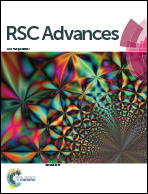Viscoelastic and durability analysis of nanostructured composite layers of polyelectrolyte and nanoparticles†
Abstract
We have evaluated the abrasion and bending durabilities of stacked polymer/nanoparticle layer-by-layer films. This was performed with a quartz crystal microbalance with dissipation (nondestructive test) and with independent abrasion and bending tests. We compared various films having different nanoparticle content ratios, or different vertical (depth) material distributions, with quartz crystal microbalance and glow discharge optical emission spectroscopy. We found that the decay times of quartz crystal microbalance were longer when there was an excess of nanoparticles in the film or if it was a uniform layered structure. Higher durabilities were also observed in these structures, which were correlated to the dissipation results. Thus abrasion and bending durabilities can be estimated using nondestructive method.


 Please wait while we load your content...
Please wait while we load your content...